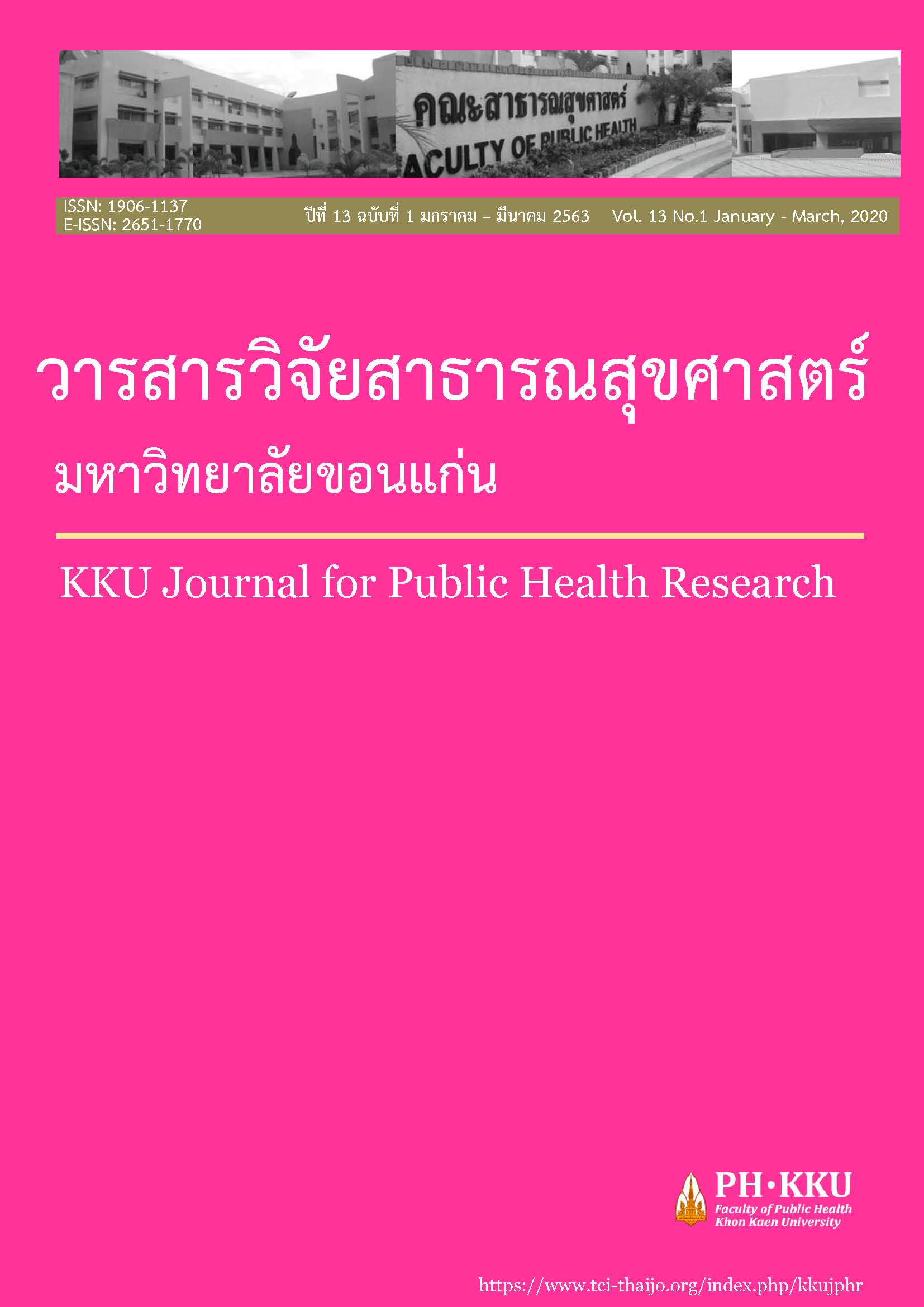The Development of Implementation Rabies Free Zone in the Community Participation in Thapra Subdistric Municipality Mueang, Khon Kaen
Keywords:
Participatory Action Research, Best Practice, Surveillance,, Prevention, Control RabiesAbstract
This research aims to study the operation and to develop the best practice in the surveillance, prevention and control rabies in Thapra Subdistric Municipality, Mueang Khon Kaen, Thailand. Participatory action research (PAR) was used with two processing cycles using OH-Smart tools. The total of 15 network partners and 200 stakeholders participate in this study. The quantitative analysis included frequency and percentages. Content analysis was used for qualitative analysis. The finding showed new insights into the concept of integration into the best practice with 3 excellent activities: 1) the establishment of the center of the shelter for stray animals 2) the establishment of the group of one health watch volunteers (Por Dee Dee Thapra), and 3) the establishment of the center of one health surveillance community called “3S Thapra Model”.
References
Bureau of General Communicable Diseases. (2011). Department of Diseases Control, Ministry of Public Health: Knowledge series of rabies. Nonthaburi: Bureau of General Communicable Diseases.
Bureau of General Communicable Diseases. (2012). Department of Diseases Control: Clinical practice guidelines for rabies and FAQ. Nonthaburi: Ministry of Public Health.
Center for Food Security & Public Health [CFSPH]. (2012). Rabies and rabies-related lyssavirus: Lowa State University College of veterinary Medicine. Retrieved October 1, 2018, from http://www.cfsph.iastate.edu/ Factsheets/ pdfs/rabies.pdf
Chaiyadhammo, P. (2017). participatory action research to develop problem-based learning in Pusjimchaingyuen Scripture School. Doctor of Education Dissertation in Department of Educational Administration, Faculty of Education, Mahamakut Buddhist University.
Day, M., Sheahan, D., Cleaveland, S., Khanna, C., Lappin, M., Palatnik-de-Sousa, C., et al. (2011). The WSAVA One Health Committee: Promoting Comparative Clinical Research. The Value of the Companion Animal Model, S112-S113.
Kamoltham, T. (2013). Pattern and strategy to eliminate rabies in the community level, by the parties and the public network by the process of the strategic pathway map. Phitsanulok: Naresuan University.
Sadeewong, A. et al. (2011). Disease investigation report: the case of the people were found that dogs that detect infections of rabies bite. Amnat Charoen: Committee on Control of Communicable Diseases between Animals and People.
Sagarasearanee, O., Hinjoy, S., Chuxnum, T., Chantean, T., Smithsuwan, P., Jorhor, N., et al. (2015). Survey of knowledge, attitude, and practice initiated by an investigation of a human rabies death in Chanthaburi Province, Thailand. Outbreak, Surveillance and Investigation Reports, 10(3), 1-8.
Silawan, S., Sajjawattana, T., Krisanasuwan, J., & Thephassad, C. (2018). Rabies prevention management in humans and animals, and at risk of disease after being bitten in Inspection Areas 13. Bangkok: National Institute for Emergency Medicine.
Sriphuwong, W., Inmuong, P., Sriphuwong, C., Nasrikane, M., Hanchai, W., Pisake, S., et al. (2004). Development of Integrated Disease Surveillance Actions on prevention and control of both human and animal rabies with community participation approach in Kantharawichai District, Mahasarakham Province. Journal of Health Science, 26(2), 299-309.
Srisai, P., Wongplugsasoong, W., Tanprasert, S., Sithi, W., Thamiganont, J., Insea, T., et al. (2013). Investigation on a dog rabies case and rabid dog meat consumption, Nakhon Phanom Province, Thailand, 2011. Outbreak, Surveillance and Investigation Reports, 6(1), 6-12.
The Thai Red Cross Society. (2018). The Thai red cross society: The campaign-day for the rabies disease 2561. Retrieved October 8, 2018, from https://www.redcross.or.th/news/ information/4898
Yangsri, H., Leethongdee, S., & Jaipakdee, J. The development of an implementation and surveillance model in the community for rabies free zone in Meungbuengkan District, Buengkan Province. The Public Health Journal of Burapha University, 12(2), 86-95.



